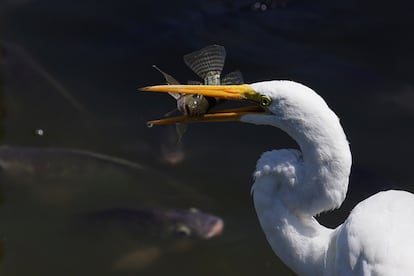EL PAÍS offers the América Futura section for free for its daily and global informative contribution on sustainable development. If you want to support our journalism, subscribe here.
On the morning of the first Monday in September, under a cloudy sky, small groups of individuals carrying binoculars, magnifying glasses, butterfly nets, tweezers and jars move slowly through the greenery of the first section of Chapultepec Park. Wearing field boots, they stop along the paths that cross the Botanical Garden, very attentive to what they can find under the serrated leaf of an agave, the low branch of a tree or the bark of a fallen trunk. They are the explorers who make up the team in charge of making an inventory of all the biodiversity that inhabits the most iconic park in the Mexican capital in a period of 24 hours.
The initiative seeks to document each of the species that live in the largest urban park in Latin America, which, according to experts, could exceed 500, including those that are registered and those new ones that can be found through this project called Bioblitz. In other words, a scientific event where the objective is to census as many living beings as possible in a given place and time. The activity also aims to contribute to connecting the public with its environment, creating awareness and interest in nature, and for this exhaustive registry to serve to make better decisions about the conservation management of this natural space, the green lung of Mexico City.
To this end, 30 specialists from various fields of biology and some 200 students spent morning and night searching for all the living beings hidden in the forest: birds, fish, frogs, axolotls, reptiles, insects, mammals, all kinds of plants and trees… But also other specimens that do not belong to the animal or plant kingdom, such as fungi, algae and lichens that make up the biodiverse fan that embraces Chapultepec. “One of the most beloved and visited places by Mexicans,” said the head of the Mexico City Environment Secretariat (SEDEMA), Marina Robles, during the press conference in which the initiative was presented on Monday.

Recognized for the value it brings to the city as the Best Park in the World in 2019 with the distinction awarded by the World Urban Parks association, Chapultepec Forest not only stands out worldwide for its natural wealth but also for the cultural and anthropological history that runs through its extensive spaces, from archaeological sites, its more than ten museums, numerous artistic centers, to artificial lakes. Inhabited by different civilizations since pre-Hispanic times, this century-old place made up of almost 800 hectares receives 24,000 visitors a year, with the first section being the busiest. “And despite all the movement it receives, any day you can see an opossum crossing its paths with its babies on its back,” says proudly Mónica Pacheco Skidmore, executive director of the park.
Although experts have already listed a large part of the species that Chapultepec is home to, they are convinced that thanks to this activity they will be able to add many others that were not part of the current catalogue until now and register some that were unexpected. “Like when in the Bioblitz that was organized in Central Park in 2003, the first one I participated in, a coyote appeared to everyone’s surprise. And that is despite the fact that this park is less diverse, much younger and has less history than the Mexican one,” says Rodrigo Medellín, a biologist at the UNAM Ecology Institute and one of the pioneers of the initiative.
After 24 hours of searching and sampling all the living beings they find, the researchers will make the results of their collection public within 15 days through a digital platform accessible to all citizens. Although this year the experts are only recording the species from the first section of the park, the activity will be repeated next year in the second, and in successive years in the third and fourth until a complete inventory is obtained. “The idea is to carry out the same experiment in a decade and prove that Chapultepec maintains its natural wealth,” said the head of SEDEMA.

In addition to creating the most comprehensive inventory of the rich biodiversity that embraces the heart of one of the largest and most polluted megalopolises in the world, and serving as a tool for improving the environmental conditions and services of the space, biologist Medellín wants the activity to help citizens get to know the beings with whom they share space up close. “Who doesn’t want to meet their neighbors, those with whom they have to live on their walks? We want the BioBlitz to also serve to make visitors to the forest fal
l in love with the nature that surrounds us and from which we come!”
#Opossums #axolotls #lichens #Chapultepec #largest #urban #forest #Latin #America #takes #inventory